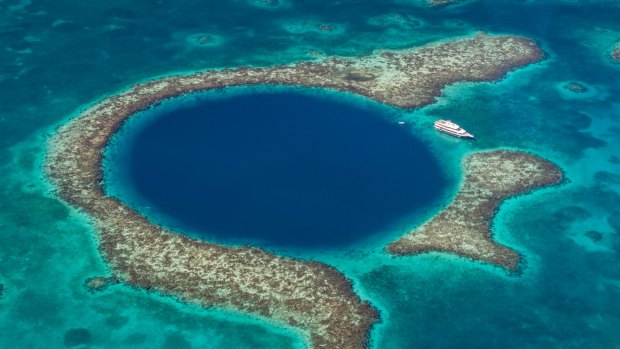This was published 5 years ago
Richard Branson to take submarine down 'The Great Blue Hole', world's largest sinkhole in Belize
By Annabel Fenwick Elliott

The Great Blue Hole off the coast of Belize. it's large enough to fit two Boeing 747 jumbo jets inside.Credit: SHUTTERSTOCK
It looks, at first, like a giant, flat, ink blot in the sea, but underneath this sinkhole – the largest in the world – is a cavern large enough to swallow two Boeing 747s with room to spare.
Famed marine explorer Jacques Cousteau didn't discover the sinkhole, located in the Caribbean sea off the coast of Belize, but he did name it "The Great Blue Hole" in 1971, and it's been a magnet for scuba divers ever since.
Now, in the first mission of its kind, Cousteau's grandson and Sir Richard Branson are plunging to the deep, dark bottom of it in a submarine as part of an expedition that will be streamed live and broadcasted globally on the Discovery Channel.
This will be quite a feat. Scuba divers generally only descend to a maximum of 40 metres underwater, so what lies beneath that remains largely uncharted territory, and there's a lot of it.
Branson and Fabien Cousteau will join Aquatica Submarines' chief pilot Erika Bergman and make several expeditions into the sinkhole this weekend in a remote-piloted Stingray 500 submarine, to collect data and map out the submerged cave.
The trio departed on Monday morning, Australian time, into the deep.
Some 100,000 years ago, this natural marvel was a network of caves that sat above sea level, with ceilings hanging with limestone stalagmites and stalactites. Over time and during our planet's latest glacial period, rising sea levels eventually flooded the structure and it collapsed to form the sinkhole it is today.
The Great Blue Hole was measured by scientists using sonar technology in 1997, but this will be the first since then and by far the most thorough exploration.
Bergman's team hope to gather scientific data on marine aspects including water quality and bacterial activity, as well to attain high-resolution footage and a detailed plan of the Hole's internal structure for the first time.
Intriguingly, they're intent on discovering what is theorised to be an oxygen-depleted layer at its base which could offer vital clues about environmental forces potentially related to the fall of the Mayan civilisation between 800 and 1000 AD.
"One of the most interesting marks that we are really excited to do is oxygen testing," Bergman told Endgadget. "We've heard that in the Blue Hole there is an anoxic layer near the bottom [and] things don't degrade in anoxic areas so we could find preserved life."
Branson is hoping that his involvement in the project will generate awareness around ocean conservation, and is supporting the goal of protecting at least 30 per cent of the ocean by 2030.
At the glance | The Great Blue Hole
- At 318 metres in diameter and around 124 metres deep, the Great Blue Hole is thought to be the largest underwater sinkhole in the world
- For scale, it could easily swallow two Boeing 747s within its cavern
- It was once a limestone cave above sea level, which later collapsed during the planet's last glacial period
- Huge, 12-metre stalactites and stalagmites remain beneath the surface
- The name was coined by Jacques Cousteau in 1971
- Since then, it's become one of the world's most famous diving sites
- The Great Blue Hole is part of the larger Unesco-listed Belize Barrier Reef Reserve System, and is located 100 km off the coast of Belize
The TV special will air on the Discovery channel on Wednesday at 9.30pm.
The Telegraph, London
See also: NZ scientists find the lost 'eighth wonder of the world'
See also: Bucket list: The seven greatest wonders of travel named
Sign up for the Traveller Deals newsletter
Get exclusive travel deals delivered straight to your inbox. Sign up now.